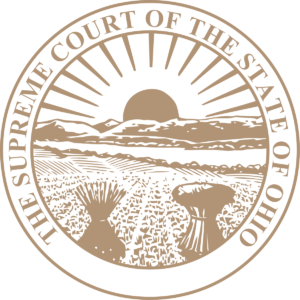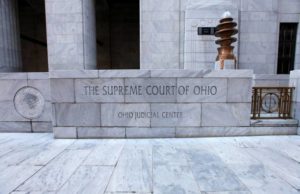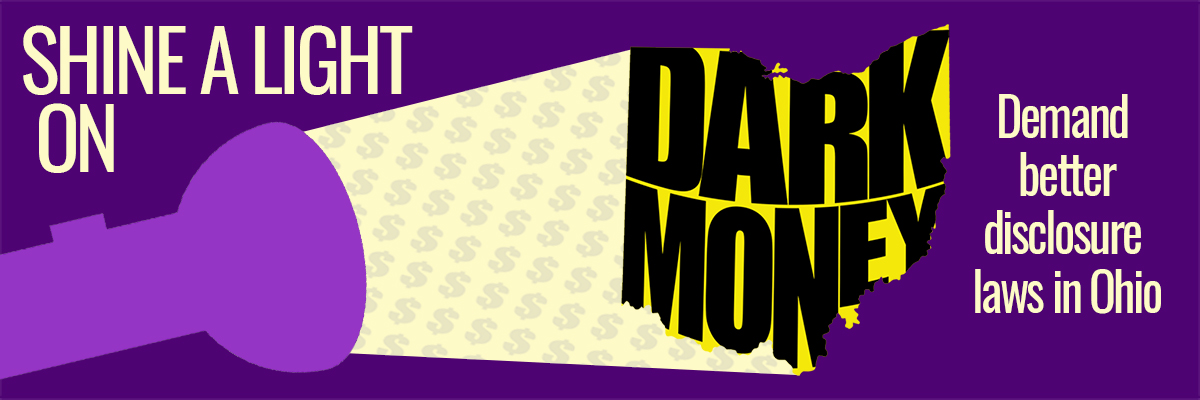Overview: Dark Money Ad Spending in the 2024 Ohio Supreme Court Election
- Total number of dark money TV ads = 14
- Total money spent on independent TV ads combined = $6,715,000 (that’s just dark $ spending on ads from five organizations!)
- Money spent to support Republicans candidates = $4,600,000
- Money spent to support Democratic candidates = $2,115,000
Who Paid for the Ads & How Much
For a quick summary of the dark money actors and their ad spending in the 2024 Ohio Supreme Court election, check out this video.
Ohioans for a Healthy Economy (2 ads): “We’re Not Safe” | “Before It’s Too Late”
A group affiliated with the Ohio Chamber of Commerce, Ohioans for a Healthy Economy Action (OHE Action), reported spending over $2.3 million backing the Republicans in the race. OHE Action received $1 million from Uihlein’s Fair Courts America, and had some other large backers including the Haslam family (which owns the Cleveland Browns) and billionaire politician Vivek Ramaswamy. Another large swath of its funding came from its 501(c)(4) affiliate, Ohioans for a Healthy Economy, Inc.
Total: $2.3 million (for Republican candidates)
Republican State Leadership Committee Judicial Fairness Initiative (3 ads): “Strong Judges” | “First Line of Defense” | “Imagine a World”
RSLC-JFI also spent around $1 million in the race with misleading ads painting the Democratic candidates as soft on crime, a regular refrain in the group’s attack ads across the country. It spent just over $600,000 on TV ads and around $400,000 on mailers.
Total: $1 million (for Republican candidates)
Frecka PAC (4 ads): “Law and Order” | “Dangerous Criminals” | “Dan Hawkins Delivers Justice” | “Justice Joe”
Frecka PAC’s sole funder was plastics manufacturer David Frecka, who pumped $2 million into the group, which in turn spent at least $1.3 million in Ohio opposing Issue One and backing the state court candidates.
Total: $1.3 million (for Republican candidates)
Ohioans for Judicial Integrity (4 ads): “Ohio Voters Read the Fine Print” | “Ohio Voters Time to Choose” | “Ohio Voters That’s News” | “Ohio Voters What Do You Call Joe Deters”
Ohioans for Judicial Integrity, funded by Michael Bloomberg and other liberal-aligned groups, spent nearly $2 million in Ohio backing the Democratic candidates.
- OJI raised $2,025,000 in 2024.
- $1,000,000 from Michael Bloomberg.
- $400,000 from the Ohio Progressive Collaborative
- $325,000 from Educators for Ohio
- $300,000 from the National Redistricting Action Fund
Total: $2,025,000 (for Democratic candidates)
Ohioans United for Public Education (1 ad): “Joe Deters is Corrupt.”
Ohioans United for Public Education filed incorporation papers with the Ohio Secretary of State on June 19, 2024, however it did not file as a political action committee and no contributions or expenditures have been reported. The group’s website describes itself as “a citizen led organization fully committed to the values that form thriving communities through robust investments in public education.”
The funding picture for this organization remains unclear as well as how much was spent on their ad attacking Joe Deters. Two 48-hour reports made with the Federal Election Commission (10/1/24 and 10/12/24) show that the entity made a $40,000 ad buy opposing Bernie Moreno in the U.S. Senate race and spent another nearly $50,000 on ads opposing Republican Congressional candidates Kevin Coughlin.
Total: $90,000 (for Democratic candidates)
“Independent expenditure” money spent by outside groups on advertising for or against judicial candidates is hard to track, because it doesn’t have to be reported to the Ohio Secretary of State. This “dark money” or secret money can play a pivotal role in Supreme Court elections.
In 2019 and 2020, campaign contributions added up to roughly $97 million was spent in all state supreme court races nationally. The 2021–2022 cycle of state supreme court elections broke numerous records with candidates, interest groups, and political parties spending a total of $100.8 million. In 2022, Ohio saw its most expensive judicial election cycle ever — $21.1 million. The money spent in Ohio mirrors a national trend in the races for states’ highest court. In 2022, Kentucky, Montana, and North Carolina also had their most expensive races for state supreme court.
Experts expected as much as $10 million dollars would be spent in 2024 on ads for and against candidates for justices of the Ohio Supreme Court; the total figure was $6,715,000. That’s a lot of money to spend without expecting something in return. It makes sense to “follow the money” and try to find out who is paying, and what they might be hoping to gain. Experts Lisa Graves and Evan Vorpahl from True North Research explore the impact of the deluge of money and wealthy special interests on our democracy.
Note: Contribution limits for candidates for justice are $7,500 from individuals and organizations. Total direct contributions added up to millions in this year’s Ohio Supreme Court races. Voters can find the identities of contributors to the campaigns on the Ohio Secretary of State’s website.
Dark Money
What is Dark Money?
Long before the secret source “Deep Throat” famously told investigative journalists Woodward and Bernstein to “follow the money’’ during the Watergate scandal, politicians and special interests have been concocting new ways to make it harder to even find the money. In 2010, the money-hiders won a huge victory in the form of a court ruling, Citizens United v. FEC, that created loopholes in campaign disclosure rules. The 5-4 ruling allowed corporations, including labor unions and nonprofits, to spend unlimited amounts to indirectly support or oppose political candidates—they still aren’t allowed to donate directly to candidates. These changes soon gave rise to politically active nonprofits—commonly called “dark money” groups—because they are intentionally structured as vehicles for anonymous political spending.
Government watchdog groups, and even top law enforcement officials, have pointed to the evils of dark money. In July 2020 when the FBI announced indictments in its public corruption case in Ohio, then-U.S. Attorney David DeVillers called dark money “a breeding ground for corruption” and he told a news conference that even the FBI needed subpoenas to trace the millions in alleged bribes through a tangle of nonprofits and other dark money groups with innocuous names such as “Generation Now” and “Partners for Progress.”
Dark money or secretly funded groups often succeed with aggressive and misleading TV commercials, online ads, and mailers that barrage voters with political messages. Most entities have ambiguous names like “Ohioans for a Healthy Economy” and “Ohioans for Judicial Integrity” that offer few clues about their true mission. Without knowing who funded the groups, voters had trouble determining the credibility and motives of the wealthy funders trying to influence the elections. Check out the section on Types of Dark Money Spending at the Open Secrets website.
In an article explaining dark money, the Center for Public Integrity states that the two most common vehicles for dark money in politics are politically active nonprofits and corporate entities such as limited liability companies. Some nonprofits—notably those formed under sections 501(c)(4) and 501(c)(6) of the tax code—are generally not required to publicly disclose their donors. Meanwhile, when limited liability companies are formed in certain states, such as Delaware and Wyoming, they are essentially black boxes: the company’s name is basically the only thing known about them. These LLCs can be used to make political expenditures directly or they can donate to super PACs.
Dark money groups are increasingly being used in judicial elections that reshape courts and threaten the impartiality of state supreme courts across the country, according to the Brennan Center. The Brennan Center publishes extensive research on the effects of dark money in politics, including its impact on state and local elections, risks to judicial independence, and the threat of foreign funds in U.S. elections.
How Do We Figure Out Who is Paying for Political Ads?
Every election season means ads in the mailbox, a deluge of ads on the television, and more candidate ads on social media. But who is responsible for these ads? Why are they spending money to try to influence your vote? What are they hoping to get out of it?
Step 1: Find the disclaimer. Is the ad paid for by a candidate or an organization?
Step 2: Attempt to “follow the money.”
- This is only easy if the ad was paid for by a candidate. Visit the Secretary of State’s site to see the contributions to the candidate.
- Ads paid for by an organization can be hard to follow. The Judge the Ads Project will do what we can to identify the source of funding, but it isn’t always possible.
Step 3: Get to know that candidates and encourage your friends and family to assess the ads as much as possible.
Step 4: Transparent elections reduce corruption and create greater accountability. Support the disclosure of political dollars!
Find the Disclaimer
Let’s take some time to learn how to judge the ads and follow the money! Your first step is to look at the “disclaimer” that explains who paid for the ad. This will tell you whether the ad is paid for by the candidate, a political party, or an organization. In the example below, the ad supporting Judge Doe was paid for by “Ohioans for Serious Justice.” That tells us that the candidate’s campaign didn’t pay for it. But who are the “Ohioans for Serious Justice”?

If the ad is paid for by a candidate committee, political party or political action committee (PAC), you can find contributions and donor information on the Ohio Secretary of State’s website.
This ad clearly wasn’t paid for by Judge Doe’s campaign, a political party or a PAC. But you might search for the name shown in the disclaimer and find nothing. Search engines can reveal an enormous amount of information, but some organizations that fund political ads are (purposefully) less than transparent.
One reason it can be hard to track the source of commercials or political ads is because of a 2010 US Supreme Court decision known as Citizens United v. FEC. In this famous case, the Court determined that corporations have the right to pay for political ads as long as they aren’t coordinating with candidates. Under law, corporations cannot contribute directly to candidates, but the court determined that corporations—including nonprofits—have First Amendment rights (free speech) and therefore must be allowed to “speak” through political ads.
WATCH THIS SHORT EXPLAINER VIDEO ABOUT CITIZENS UNITED FEATURING LISA GRAVES FROM TRUE NORTH RESEARCH
Because corporations are worried about possible adverse reactions and their bottom line, when paying for political ads, they often prefer to shield their identity. They may opt to hide behind a series of shell corporations and complex financial maneuvers in order to make it intentionally difficult to see who’s paying for what. And, while it is constitutional to require ads to include information on who paid for them (known as “disclosure”), neither the Ohio General Assembly nor the U.S. Congress passed strong disclosure rules that would help us “follow the money” to its original source.
In addition, wealthy individuals sometimes prefer to operate in secrecy. This has led to the creation of nonprofits such as 501(c)(4)s that are able to keep the list of their donors private. This makes “following the money” much more difficult.
Because only campaigns, political parties and PACs have to file with the Ohio Secretary of State, it can be hard to figure out who is paying for all the other ads. The money behind these advertisements is often called “dark money,” or secret money in elections because the source is hidden. Dark money groups can give to other dark money organizations, further complicating our ability to figure out the original source.
The Brennan Center for Justice at New York University’s Buying Time project has been tracking political ads in judicial races for more than 20 years. According to their analysis, it has become increasingly difficult to identify who is paying for these advertisements.
Ohio History
History of Secret Money in Ohio Supreme Court Races

Even before Citizens United v FEC, Ohio saw one of the nation’s most expensive and most aggressive court races in 2000. The insurance industry and the Ohio and U.S. Chamber of Commerce attempted to unseat Justice Alice Robie Resnick, a Democrat, with a dark money group, Citizens for a Strong Ohio. The campaign’s centerpiece was a TV ad featuring a statue of Lady Justice who came to life and peered under her veil to see who was placing stacks of money on her scales of justice. The ad infuriated Democrats and legal scholars for suggesting that Justice Resnick traded votes for campaign contributions. Resnick handily won re-election, and the Ohio Elections Commission ruled that both the U.S. and Ohio Chambers of Commerce broke the state’s election law by illegally using corporate money. Even though the Lady Justice ads did not specifically urge people to vote against Justice Resnick, the Commission determined they constituted political ads.
As the appeals continued, the Alliance for Democracy and Common Cause of Ohio, two non-profit organizations opposing corporate influence on government, sought the donor list for the advertisements and eventually won their release. Ohio Supreme Court contests have invited controversy—and large contributions—ever since.
In 2014, Justice Judith French received criticism for describing the court as the “backstop” for bills passed by the conservative legislature—comments that some saw as her predisposition to side with the GOP. Justice French won re-election with a campaign bolstered by about $600,000 from American Freedom Builders, a dark-money 501(c)(4) group closely tied to former Ohio Gov. John Kasich. In her 2020 re-election, Justice French again attracted criticism and dark money, this time with help from Karl Rove, the GOP gun-slinger credited with helping George W. Bush become President. In a fundraising letter to Republican donors and law firms, Rove warned that “well-funded left-wing interest groups from outside Ohio” are vying to unseat French in order to redraw the lines of state legislative and congressional districts to benefit Democrats, the AP reported.
When reporters asked Rove about his 2020 help for Justice French, he made it clear that his fundraising was unrelated to his work for the Republican State Leadership Committee (RSLC), a national dark money group whose board he had joined. Still, RSLC was airing negative television ads against then-candidate Brunner at the same time, one of which the Ohio State Bar Association asked the RSLC to pull down for being misleading, according to The Plain Dealer. The ad suggested that Brunner put the safety of children at risk when she ruled that police conducted “an unreasonable’’ search at the home of a man accused of sex crimes. “To suggest that Judge Brunner’s decision makes her ‘reckless’ or that she somehow ‘risks our children’s safety’ is misleading,’’ the bar association wrote to the RSLC.
That same year, the Ohio State Bar Association also sent a letter to Democrats critical of one of their ads, saying it “implies that contributions from ‘special interests’ influence how Justice Judith French and Justice Sharon Kennedy have and may rule in cases before them.’’ The ad criticized French for her 2016 ruling, joined by Kennedy, that held the state limit of $350,000 on pain-and-suffering damages applied to sexual assault victims, disallowing a jury award of $3.5 million to a 15-year-old girl raped by her Delaware County pastor and for which church officials were found liable, The Columbus Dispatch reported.
In 2022, the RSLC targeted state Supreme Court races with its Judicial Fairness Initiative and pledged to make “record investments in 2022 state supreme court races.’’ The announcement followed a report by the groups that said Democrats spent heavily in three states – including Ohio “to install liberal judges in their favor in redistricting cases.’’ The report did not mention that Ohio’s Republican chief justice joined three Democrats in tossing out a series of unconstitutional, badly gerrymandered congressional and state legislative district maps. Brunner, a Democrat, ran for chief justice against Republican Justice Kennedy and RSLC’s Judicial Fairness Initiative announced that Ohio’s high court contests were among those it planned to target. RSLC’s major funders include the Judicial Crisis Network, Koch Industries and the US Chamber of Commerce.
Karl Rove knew Ohio’s Supreme Court would have a big say over legislative and congressional districts. Naturally, Republicans want Ohio to maintain districts as pro-GOP as the current ones.
As Rove said in his letter supporting French, “With that court’s conservative majority again up for grabs in 2020, every conservative voter in Ohio must join the fight,” Rove wrote, describing French as “a hard-working conservative with a heart for service.”
This letter also included this line:
“Transparency enables the electorate to make informed decisions and give proper weight to different speakers and messages.”
U.S. SUPREME COURT’S CITIZENS UNITED
Karl Rove worries about the Ohio Supreme Court’s political makeup. Maybe Ohioans should, too. Trouble is, many won’t, partly because Ohio’s judicial ballot is voter-unfriendly, so voters skip it.
Drop Off in Judicial Races

In 2016, more than 5.5 million Ohioans voted for Donald Trump or Hillary Clinton or someone else for president. Also on 2016’s ballot: Two Ohio Supreme Court contests.
But just 4.3 million (80%) of the Ohioans who voted for president also voted in one of the Supreme Court races; and just 4.07 million presidential voters (74%) voted in the other Supreme Court contest. That’s called drop-off. The cause: Back then, Ohio’s ballot didn’t list a judicial candidate’s party affiliation. And campaign rules don’t let judicial candidates say anything worth remembering.
The civics book may say party affiliation doesn’t matter. Tell that to GOP presidents who nominate Republicans to the U.S. Supreme Court and Democratic presidents who nominate Democrats.
Because prior to this year, Ohio’s judicial ballot did not cue voters to a candidate’s party, candidates sometimes won, thanks to a “good” last name. “Brown” has been a winning name in the past; “Kennedy” is another.
Another reason for voter drop-off in judgeship elections: Voters might not realize how much power Ohio’s Supreme Court has over checkbooks (utility rates); insurance claims; Ohio families (divorce, custody, child support, adoption); life or death (death penalty cases) and—oh yes—politics: Whether Ohio General Assembly majorities (Democratic or Republican) can keep getting away with tilting congressional and General Assembly districts to favor one party over the other.
Ohio’s Supreme Court is now composed of four Republicans and three Democrats, and this year’s contests could change that.
Actions we can take
Dark money is a difficult problem to tackle, but there are things we can do.
- Make sure you (and your friends and family) are all registered to vote! You can register to vote, check or update your registration here.
- Be an educated voter! Use the “Preparing for Elections” section of this website to research judicial candidates. Talk to your family, friends, and neighbors about the importance of voting for judges and share this information with them.
- Don’t be a passive consumer of political advertisements. Follow the money as much as you can to see who is trying to influence your vote.
- Support legislation to reign in the impact of dark money.

